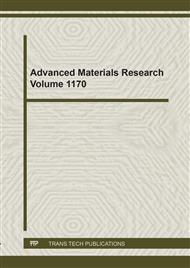[1]
R.F. Reinhardt, K.A., Reidy, Handbook of Cleaning for Semiconductor Manufacturing, John Wiley and Sons, New Jersey, (2011).
Google Scholar
[2]
V. Lindroos, M. Tilli, A. Lehto, T. Motooka, Handbook of Silicon Based MEMS Materials and Technologies (Micro and Nano Technologies), William Andrew, (2010).
Google Scholar
[3]
J. Park, K. Kwack, Crystal Originated Particle Induced Oxide Breakdown in Czochralski Silicon Wafer, J. Korean Phys. Soc. 38 (2001) 356–365.
Google Scholar
[4]
M. Hourai, E. Asayama, H. Nishikawa, M. Nishimoto, T. Ono, M. Okui, Recognition and Imaging of Point Defect Diffusion, Recombination, and Reaction During Growth of Czochralski-Silicon Crystals, J. Electron. Mater. 49 (2020) 5110–5119. https://doi.org/10.1007/s11664-020-08203-w.
DOI: 10.1007/s11664-020-08203-w
Google Scholar
[5]
G. Kissinger, J. Dabrowski, T. Sinno, Y. Yang, D. Kot, A. Sattler, Ab initio calculations and rate equation simulations for vacancy and vacancy-oxygen clustering in silicon, J. Cryst. Growth. 468 (2017) 424–432. https://doi.org/10.1016/j.jcrysgro.2016.10.073.
DOI: 10.1016/j.jcrysgro.2016.10.073
Google Scholar
[6]
B. Jean-Luc, D. Bruno, Contamination Monitoring and Analysis in Semiconductor Manufacturing, in: Semicond. Technol., Semiconductor Technologies, 2010: p.57–78. https://doi.org/10.5772/8561.
DOI: 10.5772/8561
Google Scholar
[7]
A. Nutsch, B. Beckhof, G. Bedana, G. Borionetti, D. Codegoni, S. Grasso, G. Guerinoni, A. Leibold, M. Müller, M. Otto, L. Pfitzner, M.L. Polignano, D. De Simone, L. Frey, Characterization of organic contamination in semiconductor manufacturing processes, AIP Conf. Proc. 1173 (2009) 23–28. https://doi.org/10.1063/1.3251227.
DOI: 10.1063/1.3251227
Google Scholar
[8]
K. Reinhardt, W. Kern, Handbook of Silicon Wafer Cleaning Technology, William Andrew, (2018).
Google Scholar
[9]
H. Ohta, S.M. Byeong, G.P. Jea, H.L. Sang, H.A. Jeong, H. Kwon, T. Watanabe, K. Ichinose, K. Nemoto, K.P. Sung, Quantifying yield impact of polishing induced defect on the silicon surface, ASMC (Advanced Semicond. Manuf. Conf. Proc. (2009) 41–45. https://doi.org/10.1109/ASMC.2009.5155950.
DOI: 10.1109/asmc.2009.5155950
Google Scholar
[10]
R. Vos, K. Xu, M. Lux, W. Fyen, R. Singh, Z. Chen, P. Mertens, Z. Hatcher, M. Heyns, Use of surfactants for improved particle performance of dHF-based cleaning recipes, Solid State Phenom. 76–77 (2001) 263–266. https://doi.org/10.4028/www.scientific.net/SSP.76-77.263.
DOI: 10.4028/www.scientific.net/ssp.76-77.263
Google Scholar
[11]
Y.Y. Lin, F.S. Tsai, L.C. Hsu, H.K. Hsu, C.Y. Li, Y.Y. Ke, C.W. Huang, J.M. Chen, S.J. Chang, T.Y. Lee, E. Chen, C.Y. Cheng, Fast and accurate defect classification for CMP process monitoring, ASMC (Advanced Semicond. Manuf. Conf. Proc. 2019-May (2019) 224–228. https://doi.org/10.1109/ASMC.2019.8791750.
DOI: 10.1109/asmc.2019.8791750
Google Scholar
[12]
P. Wagner, Metrology of 300 mm silicon wafers: Challenges and results, 1998 Int. Conf. Charact. Metrol. ULSI Technol. 153 (1998) 153–160. https://doi.org/10.1063/1.56790.
DOI: 10.1063/1.56790
Google Scholar
[13]
A. Zandiatashbar, B. Kim, Y. Yoo, K. Lee, A. Jo, J.S. Lee, S.-J. Cho, S. Park, High-throughput automatic defect review for 300mm blank wafers with atomic force microscope, 9424 (2015) 94241X. https://doi.org/10.1117/12.2086042.
DOI: 10.1117/12.2086042
Google Scholar
[14]
M. Akbulut, H. Lihn, M. Vaez-irvani, S. Stok, G. Zhao, W. Inspection, COPs / Particles Discrimination With a Surface Scanning Inspection System, Semicond. Int. (1999) 1–8.
Google Scholar
[15]
B. Pinto, J. Saito, W. Shen, L. Cheung, A.W.K. Corporation, New Inspection Technology for 45nm Wafers, Yield Manag. Solut. (2007) 28–32.
Google Scholar
[16]
F. Passek, R. Schmolke, H. Piontek, A. Luger, P. Wagner, Discrimination of particles and defects on silicon wafers, Microelectron. Eng. 45 (1999) 191–196. https://doi.org/10.1016/S0167-9317(99)00145-8.
DOI: 10.1016/s0167-9317(99)00145-8
Google Scholar
[17]
Y. Liu, T. Wei, M. Li, Z. Li, Z. Xue, X. Wei, Characterization of grown-in defects in Si wafers by gas decoration, Mater. Sci. Semicond. Process. 130 (2021) 105822. https://doi.org/10.1016/j.mssp.2021.105822.
DOI: 10.1016/j.mssp.2021.105822
Google Scholar
[18]
K. Xu, R. Vos, G. Vereecke, M. Lux, W. Fyen, F. Holsteyns, K. Kenis, P.W. Mertens, M.M. Heyns, C. Vinckier, Relation between particle density and haze on a wafer: A new approach to measuring nano-sized particles, Solid State Phenom. 92 (2003) 161–164. https://doi.org/10.4028/www.scientific.net/ssp.92.161.
DOI: 10.4028/www.scientific.net/ssp.92.161
Google Scholar
[19]
C.R. Brundle, Full wafer particle defect characterization, in: AIP Conf. Proc., AIP, 2001: p.285–291. https://doi.org/10.1063/1.1354412.
DOI: 10.1063/1.1354412
Google Scholar
[20]
P. Huang, Defect mapping accuracy of KLA-Tencor Surfscan 6200, 6400, and SP1, in: AIP Conf. Proc., AIP, 2001: p.317–321. https://doi.org/10.1063/1.1354418.
DOI: 10.1063/1.1354418
Google Scholar
[21]
SEMI, SEMI M52-0214 Guide For Specifying Scanning Surface Inspection Systems For Silicon Wafers For The 130 nm To 11 nm, (2014).
Google Scholar
[22]
C. Kupfer, H. Roth, H. Dietrich, Defect requirements for advanced 300 mm DRAM substrates, Mater. Sci. Semicond. Process. 5 (2002) 381–386. https://doi.org/10.1016/S1369-8001(02)00137-3.
DOI: 10.1016/s1369-8001(02)00137-3
Google Scholar
[23]
R.. Brown, F. Dupret, E. Dornberger, T. Sinno, W. von Ammon, Defect engineering of Czochralski single-crystal silicon, Mater. Sci. Eng. R Reports. 28 (2002) 149–198. https://doi.org/10.1016/s0927-796x(00)00015-2.
DOI: 10.1016/s0927-796x(00)00015-2
Google Scholar
[24]
Z. Zheng, T. Seto, S. Kim, M. Kano, T. Fujiwara, M. Mizuta, S. Hasebe, A first-principle model of 300 mm Czochralski single-crystal Si production process for predicting crystal radius and crystal growth rate, J. Cryst. Growth. 492 (2018) 105–113. https://doi.org/10.1016/j.jcrysgro.2018.03.013.
DOI: 10.1016/j.jcrysgro.2018.03.013
Google Scholar
[25]
A. Zandiatashbar, P.A. Taylor, B. Kim, Y. Yoo, K. Lee, A. Jo, J.S. Lee, S.-J. Cho, S. Park, Studying post-etching silicon crystal defects on 300mm wafer by automatic defect review AFM, (2016) 97782P. https://doi.org/10.1117/12.2220369.
DOI: 10.1117/12.2220369
Google Scholar
[26]
K.M. Saga, US10718720B2-Semiconductor wafer evaluation method and semiconductor wafer-2020.pdf, US010718720B2, (2020).
Google Scholar
[27]
J. Vanhellemont, S. Senkader, G. Kissinger, V. Higgs, M. T, Measurement , modelling and simulation of defects in as-grown Czochralski silicon, 180 (1997) 353–362.
DOI: 10.1016/s0022-0248(97)00233-9
Google Scholar
[28]
S.H. Lee, D.W. Song, H.J. Oh, D.H. Kim, Modeling of defects generation in 300mm silicon monocrystals during czochralski growth, Jpn. J. Appl. Phys. 49 (2010). https://doi.org/10.1143/JJAP.49.121303.
DOI: 10.1143/jjap.49.121303
Google Scholar
[29]
M.S. Kulkarni, A selective review of the quantification of defect dynamics in growing Czochralski silicon crystals, Ind. Eng. Chem. Res. 44 (2005) 6246–6263. https://doi.org/10.1021/ie0500422.
DOI: 10.1021/ie0500422
Google Scholar


